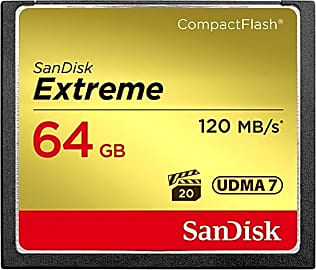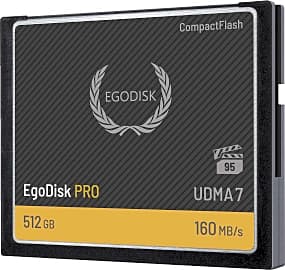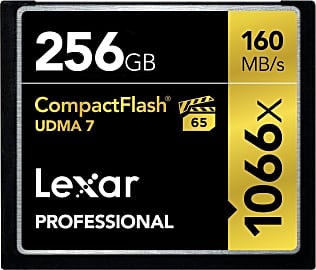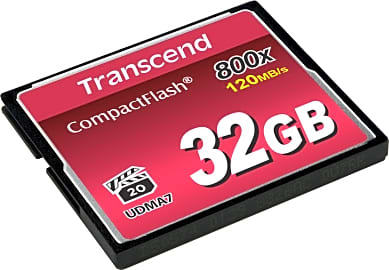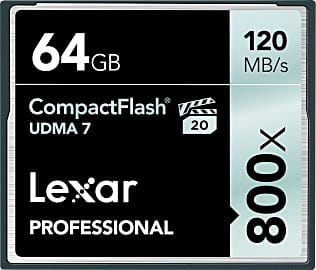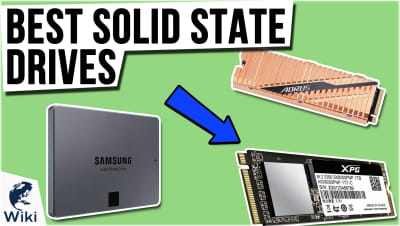The 8 Best Compact Flash Cards

This wiki has been updated 35 times since it was first published in May of 2016. Whether you are a professional photographer or videographer, or you just love to snap a lot of pictures while on vacation, you may need one of these CF cards to hold all your images. Suitable for a wide range of older stills and video cameras, these flash memory devices are ideal for high-quality portraits, 3D videos, and Ultra HD recordings, even at high frame rates. When users buy our independently chosen editorial picks, we may earn commissions to help fund the Wiki.
Editor's Notes
May 22, 2019:
While they are being phased out with regards to new equipment, Compact Flash cards were a longtime standard among professional cameras, and a lot of those devices are still perfectly useful, especially for still photography. The Lexar and Transcend 800x versions are both worthwhile for photos, though due to their relatively low minimum write guarantee, they're not ideal for recording at Ultra HD. The SanDisk Ultra is in a similar boat, although its 16-gigabyte model is particularly affordable, and is therefore great for casual photographers. Lexar's 1066x is, on the other hand, quite suitable for nearly any type of video. SanDisk's Extreme and Extreme Pro are their mid-range and high-end releases, respectively, and they're capable of pretty much any type of recording, though the former is better for photos and the latter is great for 4K video. But one of the newest players in the flash memory arena is EgoDisk, and they're apparently dedicated to provide cutting-edge memory solutions. They offer just about the only 512-gigabyte option you'll find, and all of their variants hold an impressive VPG-95 guarantee, which is 30 MBps greater than their closest competitors.
Digital Video Is Everywhere
Humans today live in what could be considered the golden age of digital recording.
It's hard to overstate the importance of digital video in our modern world. This incredible technology keeps us up-to-date on significant current events. It offers visual interpretations of the most critical world news, as well as the most exciting sporting events. Movies and television give artists a popular medium through which to express themselves while entertaining worldwide audiences. Important social and political movements gain traction through the compelling blend of visceral and intellectual pleas put forth when activists poignantly take advantage of visual media. Today's society often calls for visual proof before it believes many claims. This is due in part to the unprecedented availability of recording devices and accessories, as well as the spread of high-speed information processing.
Humans today live in what could be considered the golden age of digital recording. Smaller and faster chipsets than ever have raised the bar sky-high for mobile, accessible videography and photography. Today's best cameras are those found in mobile phones, in the vast selection of DSLRs, and among various types of filming apparatuses powerful enough to shoot entire movies in 4K resolution.
With the increasing bit rates and color depth of just video and still-image capture, attentive professionals keep their eyes on one area of particular significance: memory cards. Fast, reliable, high-capacity storage will always be of the utmost importance when handling large amounts of precise, high-definition video and audio data.
Flash Memory: How Does It Work?
One important focus of modern computer engineering has been the development of dependable high-speed data storage. Traditionally, most data is stored on computers using electromechanical means such as the standard hard drive. This works for everyday use in the home or office, but there are times when bulky HDDs certainly won't fit the bill. In order to provide fast data retention for small, portable devices, researchers have come up with methods of digital storage that stores charges within microscopic circuits rather than on a spinning disc.
Lacking any physical remnant of deleted data, flash-style memory is effective for high-security applications.
Flash memory is common in a number of popular devices today. Home computers are transitioning to solid state hard drives for the impressive rate at which the units can start up and process large quantities of information, such as when editing HD footage or playing state-of-the-art video games. Lacking any physical remnant of deleted data, flash-style memory is effective for high-security applications. Everything from smartphones to USB memory sticks to the firmware in your broadband router uses flash memory. It's truly ubiquitous, not just in the realm of video, but also in the electronics world in general.
While different types such as NAND and NOR flash (typically found in simpler electronic devices) have different architectures, their fundamental operation is similar. The controller module is a chip that's located onboard the unit in the case of USB drives and SSDs, or inside electronic devices such as cameras and cell phones. This controller writes many small pages of data, typically just a few kilobytes in sizes, onto larger blocks with capacities of around one-half to one megabyte. The total number of blocks, as well as the number of layers of data that can be stored on each one, determine the total capacity of a flash memory unit.
The physical construction and operation of NAND flash help explain a couple of the drawbacks to this non-volatile option. First of all, each block is only viable for a certain number of writes and rewrites, also called program-erase cycles. Multi-level or triple-level setups double and triple the number of charges that can simultaneously be stored in each circuit, resulting in lower-cost models than traditional single-level chips. However, this stacked configuration heavily increases the rate of redundant read/write operations across the blocks, which greatly reduces the memory's lifespan.
Also, as memory continues to be erased and rewritten, it sometimes bleeds into other, unused blocks in a process called write amplification. This can render parts of a memory chip inaccessible, leading to communication issues with controllers and computers. To combat this as well as prevent worn-out blocks, the more advanced flash units utilize wear-leveling and garbage collection techniques that help to prolong the life of modern storage cards.
Why Is Flash Important?
With endless varieties of photo and video cameras, as well as vast online communities and content sharing opportunities, it's no surprise that there's massive demand for high-speed, portable digital storage. Flash memory of different types has been the industry standard for professional photographers for over two decades. In fact, the Compact Flash Association has led the charge during that time, calling for widespread compatibility and ushering in major increases in speed and capacity.
With technology's constant attempts to better itself, more efficient communication protocols are constantly being developed.
Compact Flash cards are available in sizes from 2 GB all the way to 512 GB. In addition to high capacities, CF cards often boast high speed ratings. It's important to have a storage card that is at least as fast as your camera, to take advantage of the highest resolution video and the most rapid-fire still shots. To this end, CF cards are rated as Ultra DMA class 1 through 7, with UDMA-7 maxing out at a theoretical 167/MBps.
With technology's constant attempts to better itself, more efficient communication protocols are constantly being developed. Standards such as XQD and CFexpress will continue to evolve the flash field, allowing memory modules to more effectively interface with the computers that program them. So, while Compact Flash is still a major player, keep an eye out for the latest technologies.
As easy as it is these days to capture and preserve cherished memories and important current events, it's equally important to store that information reliably and quickly. By selecting the fastest flash storage card with the capacity to fit your needs, this task becomes much easier.



